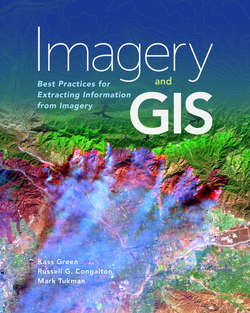Читать книгу Imagery and GIS - Kass Green - Страница 50
На сайте Литреса книга снята с продажи.
Radiometric Resolution
ОглавлениеRadiometric resolution is the minimum variation in electromagnetic energy that a sensor can detect, and therefore determines the information content of an image. Like spectral resolution, radiometric resolution is determined by the sensor.
In film systems, radiometric resolution is determined by the contrast of the film. Higher-contrast films will have higher radiometric resolutions than low-contrast films. In digital sensors, the potential range of DN values that can be recorded for each band determines the sensor’s radiometric resolution. The larger the number of bits or intensities discernible by the sensor, the higher its radiometric resolution and the better the sensor can detect small differences in energy. In general, higher radiometric resolution increases the ability to more finely distinguish features on the imagery. Discerning objects within shadowed areas or extremely bright areas is particularly enhanced by higher radiometric resolution.
Digital data is built with binary machine code, therefore each bit location has only two possible values (one or zero, on or off), and radiometric resolution is measured as a power of 2. One-bit data would result in image pixels being either black or white, so no shades of gray would be possible. The first digital sensors were 6 bit, allowing 64 levels of intensity. More recent sensors such as Landsat 8, Sentinel-2, and WorldView-3 have 11- to 14-bit radiometric resolutions (for a range of from 2,048 to 16,384 levels of intensity).
The range of electromagnetic energy intensities that a sensor actually detects is termed its dynamic range. Specifically, dynamic range is defined as the ratio of the maximum intensity that can be measured by a device divided by the lowest intensity level discernible. It is important to note the difference between radiometric resolution and dynamic range. The radiometric resolution defines the potential range of values a digital remote sensing device can record. Dynamic range is calculated from the actual values of a particular image. Dynamic range is defined by the difference between the lowest detectable level and the brightest capturable level within one image. It is governed by the noise floor/minimal signal and the overflow level of the sensor cell.
The sensor used to originally capture an image determines the radiometric resolution of the image. Thus, scanning a film image to create a digital version results in a digital image with the radiometric resolution of the film sensor, not of the digital scanner, even though the radiometric resolution of the scanner may be better than that of the film image.
